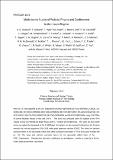Multi-device studies of pedestal physics and confinement in the I-mode regime
Author(s)
Osborne, T.; Ryter, F.; Austin, M.; Barrera Orte, L.; Churchill, R. M.; Cziegler, I.; Fenstermacher, M.; Fischer, R.; Gerhardt, S.; Groebner, R.; Gohil, P.; Happel, T.; Loarte, A.; Maingi, R.; Manz, P.; McDermott, R. M.; McKee, G.; Rhodes, T. L.; Schmitz, L.; Theiler, C.; Viezzer, E.; Walk, J. R.; Wolfrum, E.; Yan, Z.; Hubbard, Amanda E; Hughes Jr, Jerry; Marinoni, Alessandro; Marmar, Earl S; Rice, John E; Walk Jr, John R; Whyte, Dennis G; Wolfe, Stephen M; ... Show more Show less
DownloadDen Whyte 16ja004_full.pdf (3.228Mb)
OPEN_ACCESS_POLICY
Open Access Policy
Creative Commons Attribution-Noncommercial-Share Alike
Terms of use
Metadata
Show full item recordAbstract
This paper describes joint ITPA studies of the I-mode regime, which features an edge thermal barrier together with L-mode-like particle and impurity transport and no edge localized modes (ELMs). The regime has been demonstrated on the Alcator C-Mod, ASDEX Upgrade and DIII-D tokamaks, over a wide range of device parameters and pedestal conditions. Dimensionless parameters at the pedestal show overlap across devices and extend to low collisionality. When they are matched, pedestal temperature profiles are also similar. Pedestals are stable to peeling–ballooning modes, consistent with lack of ELMs. Access to I-mode is independent of heating method (neutral beam injection, ion cyclotron and/or electron cyclotron resonance heating). Normalized energy confinement H 98,y2 ≥ 1 has been achieved for a range of 3 ≤ q 95 ≤ 4.9 and scales favourably with power. Changes in turbulence in the pedestal region accompany the transition from L-mode to I-mode. The L–I threshold increases with plasma density and current, and with device size, but has a weak dependence on toroidal magnetic field B T. The upper limit of power for I-modes, which is set by I–H transitions, increases with B T and the power range is largest on Alcator C-Mod at B > 5 T. Issues for extrapolation to ITER and other future fusion devices are discussed.
Date issued
2016-07Department
Massachusetts Institute of Technology. Plasma Science and Fusion CenterJournal
Nuclear Fusion
Publisher
IOP Publishing
Citation
Hubbard, A.E.; Osborne, T.; Ryter, F.; Austin, M.; Barrera Orte, L.; Churchill, R.M. and Cziegler, I. et al. “Multi-Device Studies of Pedestal Physics and Confinement in the I-Mode Regime.” Nuclear Fusion 56, no. 8 (July 2016): 086003.
Version: Author's final manuscript
ISSN
0029-5515
1741-4326